The Ultimate Guide to Rectangle Bird Cages for Avian Care
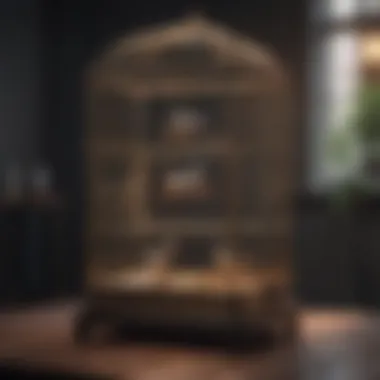
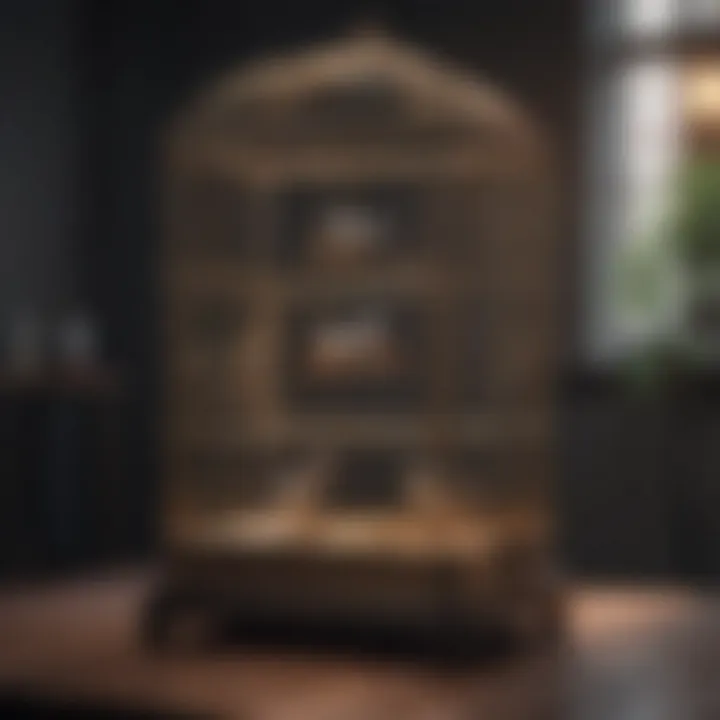
Intro
Rectangle bird cages attract their users for many reasons. One significant aspect is their ergonomic design, which optimizes space for both the caregivers and the birds inside. In terms of individual avian needs, a rectangle provides manageable areas for roaming and playing, sophistication in aesthetic appeal, and flexible internal arrangements to match various species' behavior.
Choosing the right cage involves analyzing factors beyond size, like material quality and safety. Bird owners need to be aware of the various species of birds, their unique behavioral patterns, and how this influences needs in terms of space and enrichment.
In this article, we explore the complex dimensions of rectangle bird cages that surround their design, functionality, and suitability for different bird species. This discussion carries insights into how those in charge can maintain a harmonious living environment for their feathered companions.
Care Tips
Daily maintenance is crucial for both the health of the birds and the safety of the cage environment. Regular cleaning supplies and correct setup enhance peace for the animals and ease for the caretakers. In this section, we will break this down.
Daily Care Routines
Proper care routines provide birds with stability. Establish a systematic feeding schedule to align with the natural cycles of the birds. Observing birds closely gives insight into their appetite levels and emotional states, which is helpful in feeding methods and nutrients.
Cage Setup and Maintenance
When setting up a cage, consider placement in well-lit areas away from drafts, as birds thrive best in such conditions. Regular maintenance checks are vital; structurally inspect for signs of wear, ensuring proper assembly and stability throughout their use.
Hygiene and Cleaning Practices
Cleaning is not just about appearance but also about health. Uneaten food or debris can attract harmful bacteria, compromising bird hygiene. Utilize a mix of mild cleaning solutions, sponge, and warm water to clean perches, dishes, and other surfaces adequately. Avoid harsh chemicals.
Seasonal Care Adjustments
Birds react to seasonal changes, both temperature and light. Certain species may need adjusted bedding materials and insulation during winter. Regular light exposure mimics natural patterns and can aid reproductive cycles in many species.
Behavioral Insights
Bird behavior remains a critical aspect of their health. Understanding their behaviors helps bird owners respond correctly to their needs.
Understanding Bird Body Language
Bird body language can express a range of emotions. Increased vocalization can signal stress or the need for interaction. Owners must anticipate and familiarize themselves with these cues.
Common Behavioral Issues and Solutions
Challenging behaviors such as excessive screeching or feather plucking can develop from stress. Providing stability and routine helps minimize disturbances, calms the birds, and ultimately reinforces positive behaviors.
Positive Reinforcement Techniques
Building a bond with birds includes effective communication. Positive reinforcements, such as treats for following commands or traits that are desired, encourage engagement. Each training session should feel like a game that empowers the birds.
Social Interaction Needs
Birds are social creatures and benefit greatly from interaction. Ensuring quality time through games or simple talks nourishes emotional health.
Nutrition Guides
Proper diet fulfills the essential requirements for vitality among avians. Balanced nutrition must be a priority.
Essential Diet Components
Bird diets should consist of high-quality pellets, methodically enriched seeds or grains for varied nutrition. Major components usually include fresh fruits and vegetables routinely available.
Safe and Toxic Foods
Knowledge of catalogued safe foods means educating yourself on meals such as spinach, broccoli, strawberries that birds usually love. However, toxins like chocolate, avocado, or fruit seeds must always be avoided to ensure health safety.
Supplements and Treats
Careers also need to cater to special dietary needs. Supplements like calcium are usually helpful, especially for breeding pairs, while treats must remain healthy and can be used for training motivation.
Feeding Strategies for Different Species
Every avian species has a different dietary pattern. For example,conures do better with a rich variety of fresh produce, while canaries rely significantly on different seeds. Understand and ensure grain and seed ratios match requirements.
Wellness and Health
Bird health can often behave like a reflection of habitat quality. Accordingly, routine care encompasses proactive operations.
Routine Health Checkups
veterinarians specialized in avian healthides recommendations on vaccinations and preventative health plans. Schedule routine exams, particularly annually, as crucial.
Identifying Symptoms of Illness
Understanding unique signs can help identify early health issues. Decrease in activity or appetite is quite evident among birds. Low energy is sometimes a precursor to infections and should prompt rapid attention.
Preventative Care and Vaccinations
Safeguarding birds involves adapting a routine of vaccinations and hygiene standards to keep them healthy all year round.
Mental and Emotional Well-being
Missing social contact can lead birds to isolate, maybe leading to depression. Thus, fostering an environment to promote joy and creativity shold continually mingle with the ambience.
Enriching Activities
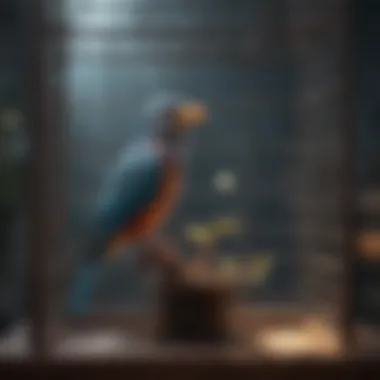
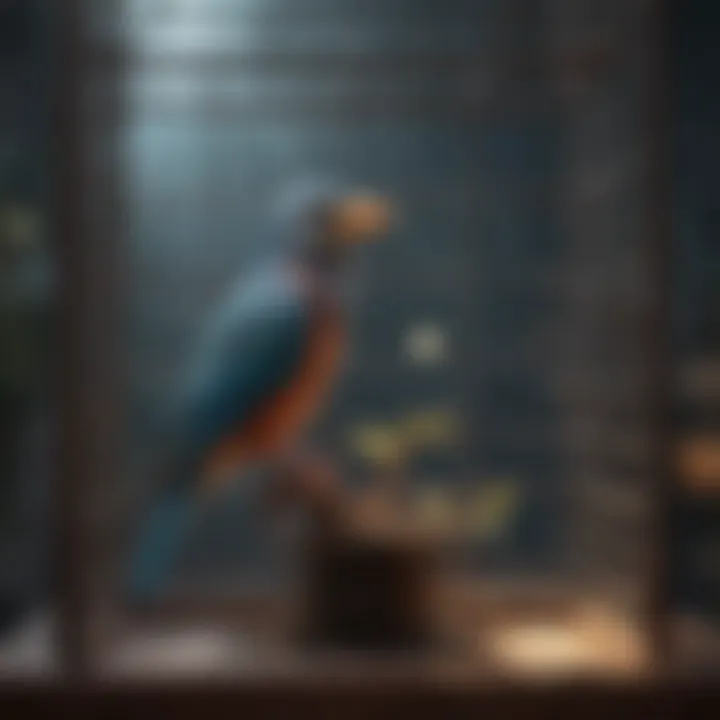
Investing time in enriching activities enhances the quality of life for avians.
Toys and Playtime Ideas
Select toys from stores equipped for pet birds as proper enrichment focuses not only on toys but can also include play areas with various textures. Rotate these designs often.
Training and Tricks
Teaching tricks not teceholds just neurotransmitters of fun; memorizing instruments into habits aids bonding.
Outdoor Activities and Interaction
Safe outdoor activities,feathered guardians will actively engage and explore their surroundings. "Dirt doesn't Ocertain it"matcher can openupto etting cage time also.|nav db gar.
DIY Projects for Mental Stimulation
Homemade enrichment bienfits include cardboard perches, allowing imaginative building. Other safe objects might make exotic possiblity appetizing.
Proper care enhances their environment, sentiment, and life longevity. Education and commitment form a frightful triad to generously secure a winged pals nation!
Understanding Rectangle Bird Cages
Understanding rectangle bird cages is vital to fostering a healthy environment for our avian friends. The shape, design and dimensions dictate not only the aesthetic appeal of a cage but also the welfare of birds they house. This section will delve into the nuances of rectangular bird cages, highlighting key features, responsibilities of the bird owners, and various considerations that come with selecting the right cage for their feathered companions.
Defining Rectangle Bird Cages
Rectangle bird cages are enclosures designed specifically for birds, exhibiting a rectangular shape. Unlike round or square cages, these rectangular structures often provide better space utilization. This design allows for more interior area, which is especially beneficial if you accommodate several birds or larger species.
Generally, rectangle bird cages are built with horizontal and vertical bars, a design element that improves visibility and airflow. These cages can be found in various sizes and widths, catering to different species and their respective behaviors.
Key characteristics of rectangle bird cages include:
- Dimensions: Varying heights, widths and lengths provide adaptability for different setups.
- Functionality: Considerations like ease of cleaning and accessibility involving main access doors.
- Material: Varied options allow for balancing aesthetic with practical needs.
This definition sets the practical framework for understanding the importance and functionality of this type of bird cage in everyday avian care.
Historical Overview
The design of bird cages has evolved significantly over the centuries. Historically, birds were often kept in simple wooden boxes with minimal room for their natural behaviors. With a growing understanding of avian needs and natural habitats in the 19th and 20th centuries, more attention was given toward optimizing bird enclosures.
The introduction of materials like wrought iron modified not only durability but made production of larger, more spacious cages viable. In many ways, the rectangle bird cage gained popularity because it provided a larger floor plan. Material advancements shifted the approach from mere enclosures to thoughtful habitats designed to simulate natural environments.
This transition underscored the evolving role of pet ownership. Birds emerged as popular pets, leading to increased demand for cages that enhance their lives rather than restrict them.
As market options expanded, more styles emerged, leading to a greater focus on features like ventilation, safety features, and overall aesthetics—not all accessories have morphed together under the label of “rectangle bird cages.” Thus, understanding the breadth of their development offers crucial context for enthusiasts today
“In seeking better environments for our pets, we actively contribute toward enhancing their welfare.”
The historical perspective added depth to the current offerings of rectangle bird cages, making many owners conscious of their choices and their birds’ well-being. By thoroughly defining these cages and acknowledging how they have progressed, existing and prospective bird owners can make informed decisions when providing their feathered companions with the best possible habitats.
Design Features of Rectangle Bird Cages
The design features of rectangle bird cages are crucial for ensuring the comfort and well-being of avian inhabitants. The choices made in designing these structures can dramatically affect how birds interact with their environment. Important elements include dimensions, the materials used in construction, ventilation, and safety features.
Dimensions and Measurements
Dimensions are foundational to the functionality of a birdcage. The rectangular design affords a balance of width and height, offering ample room for birds to move around. It's important that the cage is spacious enough for the intended species. For instance, smaller birds might thrive in cages that have wider dimensions as opposed to tall vertical spaces. Customizing the cage size to meet specific needs enhances the living conditions for birds and can encourage better behavior.
Material Selection
Materials not only impact the durability of a birdcage but also play a significant role in aesthetics and safety.
Metal
Metal bird cages are very common. One key characteristic is the strength of metal structures. Metal is a favorable choice as it typically withstands wear and tear better than other materials. Most metal cages are coated to resist rust, which helps when placed in humid environments. However, the bolts or welding points may require inspection to ensure they’re intact. Metal's hard surface can be a downside, as it may not prevent injury during flight or play.
Wood
Wooden cages bring a natural touch to the pet bird’s environment. The importance of wood lies in its warmth and aesthetic appeal. Birds often find comfort in a more organic setting. Yet, there’s a critical point to consider: untreated or low-quality wood can harm health. Thus, ensuring that the wood is safely treated to not emit toxins is essential. As pleasing as wood may be, high humidity can lead to deterioration over time.
Plastic
Plastic bird cages are lightweight and often easier to clean. One major advantage of plastic is that it can come in fashionable designs and vibrant colors. Moreover, plastic cages generally resist rust and corrosion, offering longevity when taken care of adequately. Many owners appreciate that they are usually more affordable. However, over time, plastics may become brittle or may harbor scratches that trap bacteria.
Ventilation Considerations
Ventilation is essential in any birdcage. Proper airflow helps maintain a healthy environment, preventing stagnation of air, which can lead to respiratory issues for birds. It’s wise to choose cages with bars that allow for adequate circulation while keeping the birds safe. Some design choices, such as extra mesh screens, can also enhance airflow without compromising security.
Safety Features
Birds need safe environments. Incorporating solid safety measures adds another layer of comfort.
Bar Spacing
Bar spacing is a key factor. It must not be too wide to avoid escape or injury. A central aspect of good bar spacing is knowing the bird species; different species have different needs. Too wide of spacing can lead to accidents, while too narrow can feel restrictive. Many popular rectangular cages have adjustable bar spacing as additional feature, which can be very convenient.
Lock Mechanisms
Lock mechanisms correlate with safety and ease of access. A reliable locking system is necessary to prevent pets from escaping and unwanted entities from accessing the birds. Some locks allow for user-friendly operation while minimizing risks. Choosing strong and sturdy locks can relieve a bird owner’s worries about safety while allowing for unhindered access.


In summary, The design features of rectangle bird cages significantly contribute to the welfare, security, and happiness of birds, making thoughtful design choices a priority for current and prospective bird owners.
Advantages of Rectangle Bird Cages
The choice of a bird cage is crucial for optimizing the living conditions of your avian companions. Understanding the advantages of rectangle bird cages adds depth to this decision-making process. Rectangular cages provide numerous benefits, particularly when compared to other shapes. These benefits encompass effective space management and opportunities for customization, which can greatly improve the comfort and happiness of the birds housed inside.
Space Utilization
One of the most notable advantages of rectangle bird cages is superior space utilization. Unlike round cages, rectangular shapes allow for a more strategically comprehensive use of the internal area. You can place perches, toys, and feeding stations in a way that maximizes easy access for the birds while ensuring they have areas to move about comfortably.
When selecting a rectangular bird cage, it is important to consider its dimensions. Wider and deeper cages can foster better flight paths and exploration. Some examples include:
- Multiple Levels: Rectangular cages often encourage a design that permits vertical positioning as well—a feature eagerly welcomed by species such as cockatiels or lovebirds.
- Variety In Configuration: The layout can facilitate a diversified habitat that caters to the behavioral needs of various birds. Space can be allocated for resting and activities, thus promoting physical and mental well-being.
- Easy Access for Owners: For bird owners, rectangular cages often offer easier access for cleaning and maintenance due to their shapes, allowing for thorough examination without additional stress on the bird.
In increasing fulfillment, optimizing the space within rectangular cages proves beneficial for a variety of avian life forms.
Ease of Customization
Another critical element of rectangle bird cages is their adaptability. These cages allow for extensive customization tailored to the specific needs of the birds they accommodate. An owner can personalize configurations to fit them into a bird's habits and preferences. Consider that setups can reflect creativity aimed at enhancing enrichment.
Benefits of customization include:
- Adjustable Perches: Arranging perches at varying heights and angles enhances exercise routines. Birds can freely choose perches best suited to their comfort.
- Modular Designs: Many rectangle models support enhancements through modular additions. This can include additional compartments purely for nesting or entertainment.
- Incorporating Accessories: You have the flexibility to integrate diverse accessories like toys, natural branches, food holders, and hideaways, which render an inviting atmosphere that replicates a more natural environment.
Customizing the bird cage encourages an engaging habitat. Bird owners can not only provide practical benefits but contribute to reductions in problems related to boredom or stress within the birds.
Ultimately, understanding the advantages of rectangular bird cages empowers bird owners to cater effectively. Ensuring proper space utilization and customization provides the foundation that supports a healthy avian life.
Disadvantages of Rectangle Bird Cages
Understanding the downsides of rectangle bird cages is a vital part of selecting the right habitat for your avian friends. While these cages offer numerous benefits, being aware of the potential disadvantages helps bird owners ensure the well-being of their pets. This section will address the limited vertical space that rectangle bird cages often present, and why this matters.
Limited Vertical Space
One of the major disadvantages of rectangle bird cages is their limited vertical space. Birds are naturally inclined to fly and perch, and the capability to move vertically is crucial for their physical and mental health. This is particularly important for larger breeds, whom may thrive better in a setting that allows for expansive movement.
When cage height is restricted, it can hinder important behaviors such as flying, climbing, and exploring. Many parrot species, for example, are known for their acrobatic abilities and benefit greatly from an environment where they can ascend to higher points. A cage lacking sufficient vertical space may lead to not just frustration, but also detrimental health issues over time.
In consideration of the needs for vertical space, here are several points to note:
- Physical Health: Limited height can result in sedentary behavior, which in turn, may lead to obesity or muscle atrophy in birds.
- Mental Stimulation: Birds deprived of the ability to climb or navigate higher areas may become bored and engage in undesirable behaviors, such as feather plucking or excessive squawking.
- Compatibility: Different species have varying spatial needs; parakeets might adapt better to smaller spaces than heavier birds like cockatoos or macaws.
When selecting a cage, consider the species of your bird and always prioritize ample vertical space. If a rectangular design catches your eye due to its structural benefits, remember to also assess its height.
In summary, the limitations of vertical space in rectangle bird cages adopt a significant facet within this habitat discussion. Balancing such structures while fulfilling personal preferences can be a challenge. By recognizing these challenges, bird owners can make informed decision pertaining to their birds' housing needs. An adequate understanding of these limitations enables proper adjustments to resource availability, influenceace in housing styles, and ultimately, the overall wellbeing of your avian companions.
Choosing the Right Size
Choosing the right size for rectangle bird cages is vital for both the health and happiness of the birds. An appropriately sized cage enhances birds' quality of life, providing them with enough space to stretch their wings and move freely. Selecting the right size does not just enrich their environment; it also reduces stress and encourages natural behaviors. A well-sized cage allows owners to customize the interior, making it a beneficial habitat for the birds.
Determining Size Requirements
Species-Specific Needs
When selecting a cage size, a key consideration is the species of the birds. Each bird species has unique space and activity requirements, which dictate the appropriate cage dimensions. For instance, larger birds like macaws require more expansive cages than smaller species, such as budgerigars.
Understanding specific needs can prevent aggression and behavioral issues. Birds that are stressed due to cramped settings may exhibit destructive behaviors. Thus, ensuring the cage matches the specific needs of the bird species serves as a structural necessity and a pathway to healthy, happy birds.
Also, an important aspect of species-specific needs is that certain birds enjoy climbing and flying. Providing ample room accommodates these characteristics, thus affirming why it is a popular choice among bird owners. Deliberately considering such traits enhances the bird's wellbeing.
Number of Birds
The number of birds housed in a cage is equally important. Each bird should have enough space without feeling overcrowded. A cage that is too small for multiple birds can lead to rivalries and stress-related behavioral issues. Therefore, the dimension of the cage needs to allow sufficient room for every individual animal. In many cases, a larger cage is more beneficial as it provides opportunities for companionship and social behavior while mitigating the chances of territorial disputes.
More importantly, adequate space translates to better heart health for birds, as it allows for necessary movement. In this light, considering the number of birds directly relates to making knowledgeable decisions about suitable cage dimensions. Overcrowding not only damages the perception of the cage but also hinders overall quality of life for its inhabitants.
Recommended Dimensions for Common Species
When it comes to recommended dimensions, different birds have varied requirements. Here is a general outline:
- Budgerigar: A minimum of 18x18 inches floor space, and at least 18 inches in height.
- Cockatiel: A minimum of 24x18 inches for the floor space with at least 24 inches height to accommodate their active nature.
- Parrot: For mid-sized parrots like conures, a 30x20 inches dimension is necessary.
- Macaw: Macaws, being larger birds, as a rule of thumb should have at least 36x24 inches with greater height.
These recommendations aim to support proper activity levels, promoting physical and psychological health.
Maintaining Rectangle Bird Cages
Proper maintenance is critical for rectangle bird cages to ensure a healthy and safe environment for birds. Birds require clean surroundings to thrive, and the cage itself serves as their home. Negligence in upkeep can directly affect their well-being and quality of life. Therefore, understanding the maintenance considerations is key for bird owners. Regular cleaning and inspection are more than just good practices; they are essential responsibilities of bird caretakers.
Regular Cleaning Protocols
Cleaning bird cages regularly to ensure hygiene is crucial. A dirty cage can lead to bacterial growth, affecting birds' health adversely. Here are some effective cleaning protocols:
- Daily Cleaning Tasks: These should include removing soiled food, droppings, and replacing water. This minimizes foul odors and reduces the risk of infection.
- Weekly Deep Clean: At least once a week, a thorough cleaning should occur. This includes taking all accessories out, wiping down surfaces with bird-safe cleaners, and disinfecting any corners or hard-to-reach areas.
- Proper Materials Needed: Choose non-toxic, safe cleaning agents, such as vinegar or baking soda, which are effective without harming the birds. Ensure any food they can reach is avoided during cleaning.
Following these steps can significantly improve your bird’s daily environment. It encourages healthy behaviors and ensures they feel secure in their space.
Inspecting for Wear and Tear
Examining the cage periodically for damage must be a routine component. Any sign of deterioration can present hazards for the birds, compromising their home. Regular inspections help catch problems early. Here's how to approach this process:
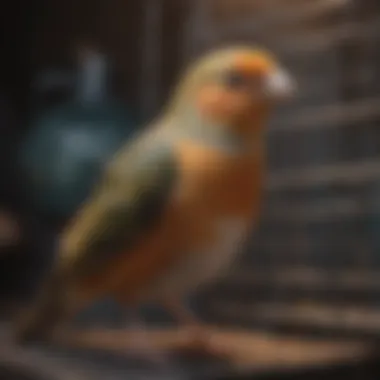
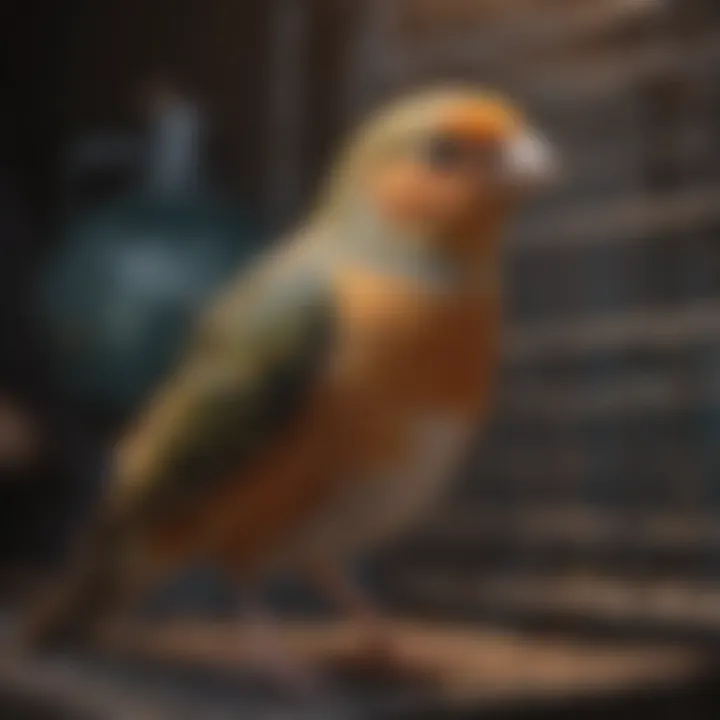
- Inspect Structural Integrity: Check for rust in metal cages or cracking in plastic ones. Areas with potential weak points, such as welds or where material connects, require extra attention.
- Monitor Accessories: Toys, perches, and other elements inside the cage should be assessed routinely. Look for signs of wear like fraying or breaking. Replacing unsafe items immediately is very important to avoid injury.
- Check Bars and Locks: Evaluating spacing between bars is significant to prevent escaped birds. Also, inspect locks to confirm they work well. A malfunction there can cause birds to escape suddenly.
By implementing proper inspection methods, accessibility to a safe living environment is established and maintained. Careful approaches help to secure their habitat against potential issues before they arise. Remember, proactive maintenance leads to a happier bird.
Creating an Enriching Environment
Creating an enriching environment is pivotal for the physical and psychological well-being of birds housed in rectangle cages. Enrichment refers to elements that stimulate the social, mental, and physical aspects vital to avian life. Without these, birds can develop stress and boredom, which potentially leads to behavioral issues. By incorporating thoughtfully chosen toys, accessories, and natural elements, bird owners can fulfill their avian friends’ needs effectively.
Toys and Accessories
When it comes to enhancing life in a rectangle bird cage, toys and accssories play an essential role. These items aid in keeping birds active, curious, and engaged. Consider the following types:
- Chew Toys: Birds love to chew. Natural, untreated wooden chew toys can keep their beaks healthy while offering stimulation.
- Swinging Perches: Perches that swing allow birds to engage their muscles and offer a different viewpoint within the cage.
- Climbing Structures: Incorporating ropes, ladders, or even playful multilevel platforms involves birds in movement and exploration, mirroring their natural tendencies.
- Puzzle Feeders: These challenge birds to work for their food, enhancing their problem-solving skills and keeping them occupied for extended periods. Knowing what your specific bird enjoys will guide the choices for its enriching environment.
Care should be taken during selection, as materials must be safe for bird consumption, with no toxic substances. Regularly rotating toys can maintain their interest, ensuring they don’t become stale over time.
Natural Elements
Natural elements are another crucial component for creating a stimulating atmosphere. This trend of nature inside a cage allows birds to explore textures, scents, and forms they would find in the wild. Important considerations include:
- Branches and Perches: Using natural branches provides variety in perch size and stability, which mimic a natural habitat. Choose wood that is non-toxic, such as manzanita or willow.
- Greenery: Adding spikes of safe, bird-friendly plants like spider plants or potted herbs beautifies the cage while offering additional enrichment. Be aware of any plant toxicity, ensuring safety first.
- Not Sandbox or loam Substrates: Allowing your birds to scratch around more intrinsic environments can enhance digging and foraging instincts. All kinds of visual layers contribute to making the cage feel comfortable and alive.
In summary, considering both toys and natural elements is an integral part of nurturing a thriving environment. By choosing these intentional pieces, pet owners demonstrate their commitment to their birds' well-being, fostering happier, healthier feathered companions.
Regular interaction with your bird in conjunction with environmental enrichment leads to a truly harmonious living situation.
Behavioral Considerations
Behavioral considerations play a critical role in providing an optimal living environment for birds housed in rectangle cages. Understanding these factors is essential for caregivers, ensuring the psychological and physical well-being of these avian companions. This section highlights key elements that affect behavior and social interaction, ultimately contributing to a more enriching habitat.
Understanding Bird Behavior in Cages
Birds are social creatures. They exhibit varied behaviors influenced by their environment. A rectangle bird cage should facilitate these behaviors, allowing birds to interact with their surroundings. Physical space, stimulation, and social dynamics are key aspects that come into play.
When birds feel restricted, this can lead to stress or frustration. Observing their reaction to space can provide insights into their needs. For example, a tamagnum or lovebird may thrive in areas where they can fly short distances, especially their wings are clipped. Birds are prone to boredom without stimulation from toys or shifts in scenery. This can be really imprtant also.
Birds also express their instincts and emotions through different behaviors. One must take passions like, perching, climbing, preening, and foraging into accout when designing a cage setup. Ideally, the cage should encourage them to engage in activities natural to their species, providing opportunities to exercise their wings and beak.
Important Behaviours to Promote:
- Foraging: Birds engage their curiosity by searching for food. Thus, enrichment toys combining food challenges can keep them engaged.
- Climbing: Rectanglar cages allow for vertical space if decorated wisely hosing shelves or branches.
- Communication: Birds tend to mimic or engage in vocalizations, explaining the need for social creatures to communicate.
Social Interaction Needs
Social interactions are essential. Birds are often happiest when they live in pairs or groups. In rectangle cages, social needs can be supported not just by housing multiple companions but also through daily interaction with their human owners.
Visual and auditory stimulation from outside the cage is also vital. Birds can benefit from observing other animals or humans. This exposure satisfies social curiousity, keeping them mentally active. Regular interaction with companions can safley boost the confidence of the lead bird.
Interactions should aim to encourage extremely positive reinforcement moves. Treats aren't just a reward but provide valuable interactions were bond can show how to be socially interacted.
Caring for a single bird usually comes with a level of commitment. Aviaries or large communities setups not an always can be better, adding to the psychological need. The design and furnishings of the cage matter significantly. Configuration will impact how birds interact with the features it possesses.
“Understanding and meeting social interaction needs can improve the well-being of captive birds. Their happiness reflects their environment and enrichened interactions.�”
In summary, recognizing behavioral elements and promoting social connections significantly impacts a bird's quality of life. Itemizing their needs assists the alignment between their Lives and that of the caregiver. Addressing both points will ensure birds thrive in their rectangular habitats.
Safety Precautions
The welfare of avian inhabitants depends on the safety features of their living spaces. Rectangle bird cages can offer a suitable environment, provided they are managed correctly. This section emphasizes the necessity of careful attention to safety precautions to mitigate risks and enhance the health of birds. Avoiding hazards and being prepared for emergencies are crucial elements in ensuring that feathered companions thrive.
Avoiding Hazards
Hazards are prevalent in any environment, including living spaces for birds. Pet bird owners must be vigilant to reduce potential dangers.
Some common hazards to consider include:
- Toxic materials: Certain household items like cleaning chemicals, plants, and metals (like lead) can be harmful to birds. It’s important to research pet-safe products to maintain a secure environment.
- Sharp edges: Inspect the cage for any protruding edges that could injure birds. Ensure that all cage components are smooth and securely attached.
- Toys and accessories: Many toys are made with untreated wood or harmful paints. Choose bird-safe toys and supervise their condition to prevent choking or injury. Always watch for frayed pieces or potential pieces birds can pull apart.
- Choking hazards: Avoid small items that can be swallowed, and monitor toys for loose parts. Birds are naturally curious, so safeguarding against these hazards should be a priority.
It's essential to regularly review the cage and surrounding area for any newly arisen dangers. Make adjustments to maintain a safe habitat.
Emergency Preparedness
Preparing for future emergencies can prove crucial. Birds, similar to other pets, can become stressed in unforeseen situations. Creating a contingency plan is an effective strategy.
Amidst emergency preparedness, consider:
- Creating a bird first aid kit: Include supplies like bandages, a disposable syringe, and avian-specific medications. Store the kit in a location known to all caregivers.
- Knowledge of avian vets: Have a list of avian veterinarians readily available, including after-hours contacts. Being able to access medical help quickly can be life-saving.
- Escape readiness: Understand how to secure the cage during evacuations. Maintain a way for the bird to escape quickly should they become frightened.
- Stress minimization: In emergencies, birds may feel distressed. Have a plan prepared so all household members consistently know how dealing with the birds helps in reducing stress.
Preparedness ensures enjoyment when bird ownership is uplifting but readying for emergencies can only help to alleviate unforeseen dilemmas. Remember, a sensible approach strengthens the safe enjoyment of bird keeping.
The End
In this article, we analyzed the various dimensions of rectangle bird cages, their design, functionality, and their profound impact on the well-being of birds. Understanding the role these cages play is crucial for both uh bird enthusiasts and caregivers. Knowing how to optimize their environment enhances the livability and comfort for our feathered companions.
Recap of Key Points
This guide covered several important elements:
- Design Features: We discussed material selection along with size specifications necessary for ensuring comfort and safety.
- Advantages: Rectangle bird cages often provide better space utilization and are easier to customize than other shapes.
- Disadvantages: It's important to note potential limitations in vertical space, which could affect certain bird species.
- Maintenance: Regular cleaning and inspection for wear and tear emerged as key practices for cage upkeep.
- Enrichment: Keeping birds engaged with toys and natural elements can drastically improve their mental health.
- Safety Precaution: Recognizing hazards and being prepared for emergencies is necessary for bird safety.
Having a bird and caring for it is not just about providing a cage, but understanding the nuances that come with optimizing their habitat to elevate their quality of life.
Final Thoughts on Rectangle Bird Cages
Selecting the right enclosure for a pet bird necessitates thorough research and consideration. Rectangle bird cages can indeed be a smart choice if they meet the specific needs of the species. They facilitate ease of access for care while ensuring comfort through adaptability.
A well-chosen cage promotes both physical and emotional wellbeing. The key takeaway lies in a balanced approach: create a space that’s spacious for your birds while assuring their freedom of movement and safety. Focus on incorporating natural elements and dynamic accessories (like perches, swings, and chew toys) to cultivate a stimulating environment.















